| FlutterFlow Pros | FlutterFlow Cons |
|---|---|
| Fast prototyping | Imperfect code possible |
| No-coding required | Unpredictable updation mechanism |
| Supports custom code | Possibility of bugs |
| Robust platform | No real two-way sync b/w local codebase & online editor |
| Dynamic and collaborative development environment | Complex conceptual mechanisms |
| Easy firebase integration | No proper video tutorials |
| Custom widget import | Limited preset widgets |
| Drag & drop ecosystem | State and error management |
| Frequent updates | Lack of proper documentation |
Summary:
Post-COVID-19 pandemic, many business owners have shifted to the online marketplace, while others are adapting to the changing trends. Traditional developers, citizen developers, designers, and novice coders have also emerged as an asset to the development marketplace catering to this radical shift. FlutterFlow has come out as a significant choice amongst many no-code platforms. To address this fact, in this blog post, we will dive into the comprehensive details of this low-code platform, including the introduction, history, features, advantages, and disadvantages. Also, we will explore its popularity metric along with a circumferential comparison of Flutter Flow with other low-code platforms like Draftbit and Bubble.
Table of Contents
Introduction to FlutterFlow
Gartner estimates that by 2024, 65% of application development will be done using low-code tools. FlutterFlow is a browser-based online app builder platform allowing users to create native cross-platform applications. It is a step further by the Flutter framework introducing a third-party visual app builder that helps speed up the development process significantly.
However, the crucial feature that makes it stand out is the ability to build an application without code. It allows for intuitive interfaces that can help businesses scale the time needed to launch an application within the market. It follows a drag-and-drop interface to build mobile applications visually without writing any code. Flutter Flow is highly efficient in businesses such as healthcare, banking, education, technology, and similar other sectors to develop, manage, customize, test, and deploy mobile applications with little or no code.
History of FlutterFlow
FlutterFlow enables developers to design and personalize mobile applications using pre-defined templates, custom widgets, graphical user interface (GUI) builder, layout elements, and Lottie animations. But the question is, Why? Well! The answer lies in the ‘History of FlutterFlow.’ Let us get to it.
A few years back, some Google engineers collectively created a cross-platform application development tool called Flutter, enabling developers to make and run their mobile applications on Android and iOS. Using Flutter for app development became a common trend among developers in a very short period due to its practical cross-platform functionality. Also, Flutter made the development process simple and easy.
Two former Google engineers, Abel Mengistu, and Alex Greaves, decided to have a venture of their own and created the FlutterFlow. It possesses the full potential of the Flutter framework with an add-on feature of a drag-and-drop interface. It enables effective and easy code building even for citizen developers. Its introduction aimed to make it easier for designers, developers, and entrepreneurs to build mobile applications quickly. In October 2022, version 2.0 of Flutter Flow was released with many additional features.
Features of FlutterFlow
FlutterFlow community has offered many features in FlutterFlow, making it an exceptional choice for citizens and traditional developers. Its extensive and exceptional drag-and-drop system makes it a viable and preferred choice for app development. Some of its most significant features are as follows:
- It allows you to create breathtaking applications without writing a single line of code. This exceptional feature of Flutter Flow allows for application creation for designers, entrepreneurs, and early-stage or citizen developers.
- It enables you to simultaneously create Android, iOS, web, and desktop applications that entail almost a significant portion of the devices and users. This saves a lot of time and effort.
- It offers a wide range of UI templates and components, including approximately fifty screen templates and group/individual chat templates that offer vibrance to the application with widget animations and Lottie and Rive animations.
- It offers easy switching between light mode and dark mode based on their preference.
- It makes sending push notifications to various users easy and triggers engagement.
- It also offers easy third-party integrations that include OpenAI, CodeMagic, Algolia, and RevenueCat.
- FlutterFlow community has offered application connectivity with the live data using Firebase for Flutter Flow, i.e., the setting up of the data infrastructure, which is a crucial factor for the success of any application.
- It allows seamless user registration, log-in, and authentication with Firebase, Google, and Facebook, which is a significant requirement for the security of any application.
- Its GitHub configuration allows seamless linking of the application projects with the growing GitHub repository. This allows the application creators to leverage the GitHub benefits.
- FlutterFlow’s source code is still with you, so you can download and build applications seamlessly.
- You get guided troubleshooting access that empowers you to address roadblocks via real-time feedback and course corrections efficiently.
- If a team with multiple developers is building an application, in that case, FlutterFlow enables easy collaboration with the team members.
To know more, refer to FlutterFlow Features.
Flutter Flow Pros and Cons
Every platform has advantages and disadvantages, and FlutterFlow is one of them. It is easy to use, with fast prototyping, and much more, accompanied by a few drawbacks, like the lack of extensive official support from the FlutterFlow community. Considering this let us jump onto a few benefits and drawbacks of FlutterFlow:
Confused! How Can FlutterFlow Scale Up Your App Development?
Hire Flutter Developer and dive into the future of app development with no-code platforms to get ahead of the curve.
Why is FlutterFlow Popular?
Flutter Flow uses the Dart programming language and is one of the best low-code tools for citizen developers and entrepreneurs. It allows for compiling the code into different platforms without complexity, compilers, or other software involvement. It also enables you to create applications swiftly, with the option for extensive scalability.
But the question persists: What is the reason behind FlutterFlow popularity? The answer is simple engagement and addressing the issues of the end-users. But How? Well! Where the user engagement holds the maximum value, Twitter. It is where Flutterflow.io brings out everything they address and enables the community and developers to get their issues addressed. A few recent announcements by the Flutter Flow team are:
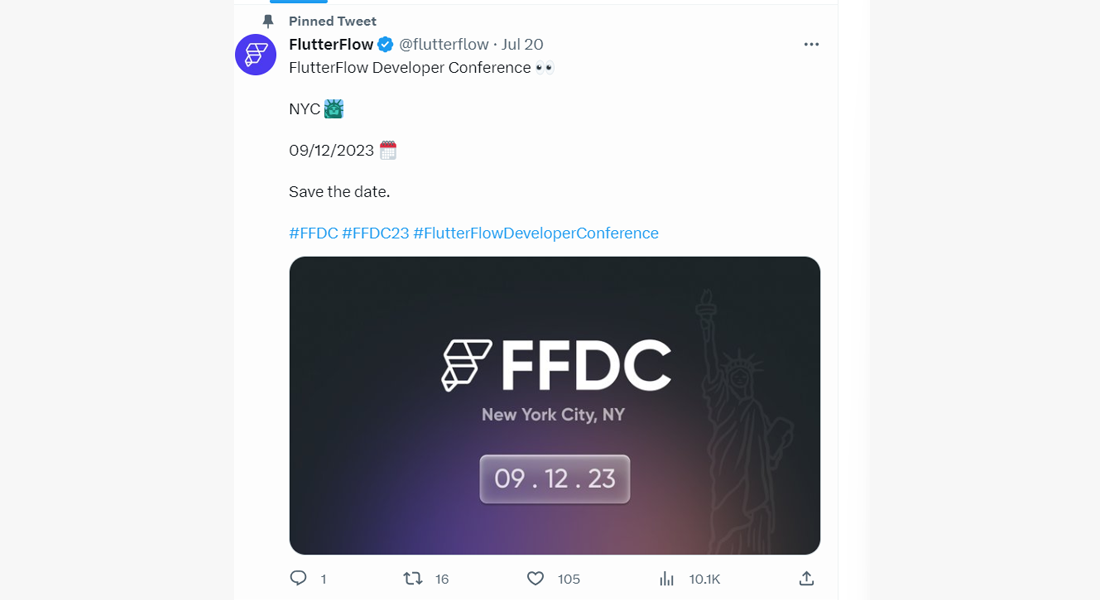
- The first-ever FlutterFlow Developer Conference (FFDC) was announced on 09/12/2023.
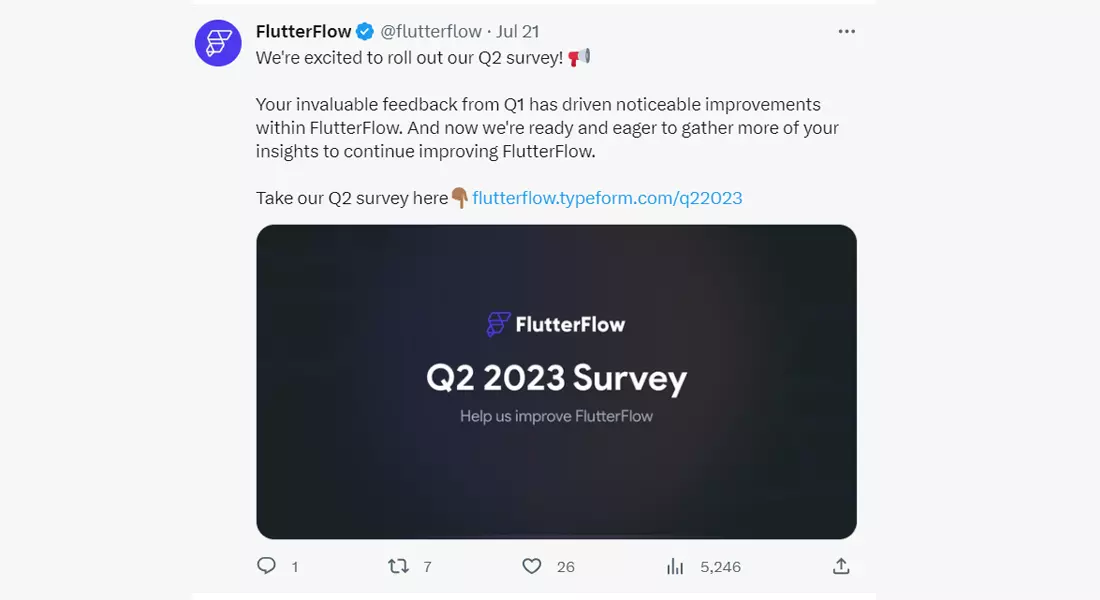
- They recently rolled out the form for the Q2 Survey to introduce more functionalities and features within FlutterFlow after the successful feedback and implementation of the Q1 Survey.
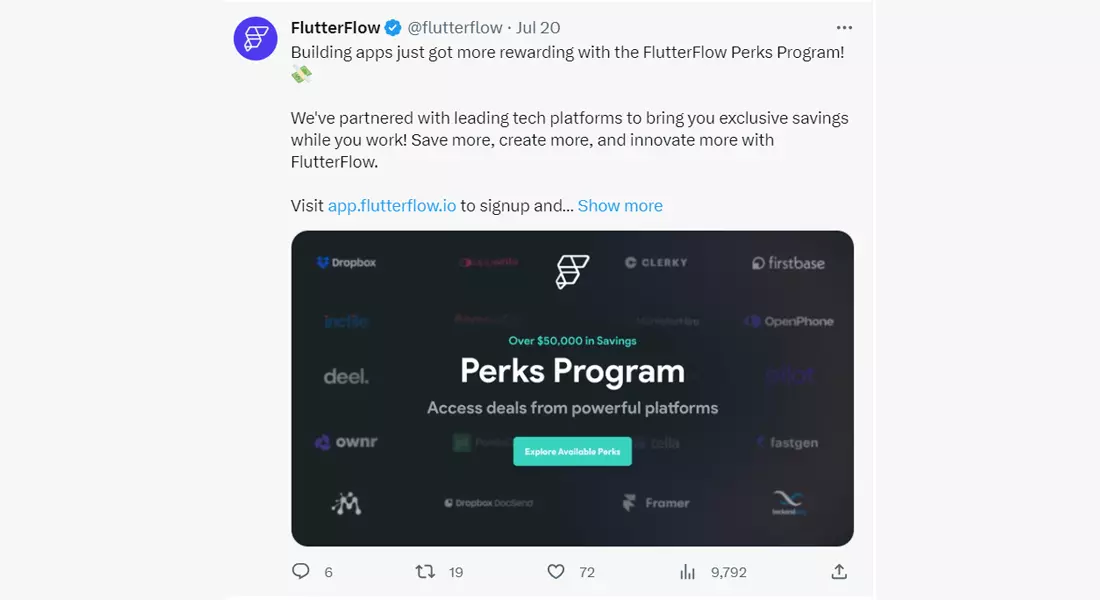
- The FlutterFlow Perks Program, whereby they have partnered with leading platforms to bring out the most exclusive savings while working. To know more, you can visit flutterflow.io.
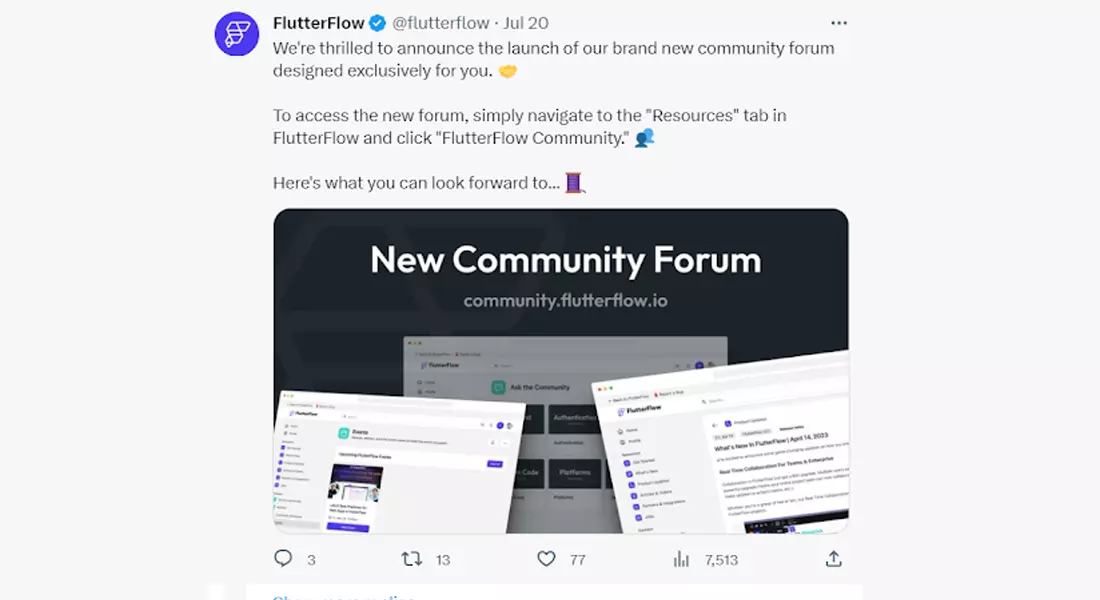
- Along with the number of features, they have announced the latest FlutterFlow Community, the brand-new community forum designed exclusively for developers.
These were just a few of the latest points for the FlutterFlow community, announced for their users, including novice developers, citizen developers, designers, or anyone who prefers building an application on a low-code platform. You can refer to their official Twitter handle to learn more about such posts.
The Relationship Between FlutterFlow and AI
Well! AI or Artificial Intelligence is the new talk of the town, and with Google’s Bard and ChatGPT that have taken the whole market by storm, how can the FlutterFlow community be any point apart from this segment? Therefore, they have introduced their latest FlutterFlow AI Gen. This AI Gen enables you to leverage the power of AI in FlutterFlow and generate code, styles, and database schema with simple and effective prompts. This AI Gen is an assistant for every step of the application development journey to design, build and launch multilingual, responsive Flutter applications leveraging the power of FlutterFlow. The features of AI Gen are as follows:
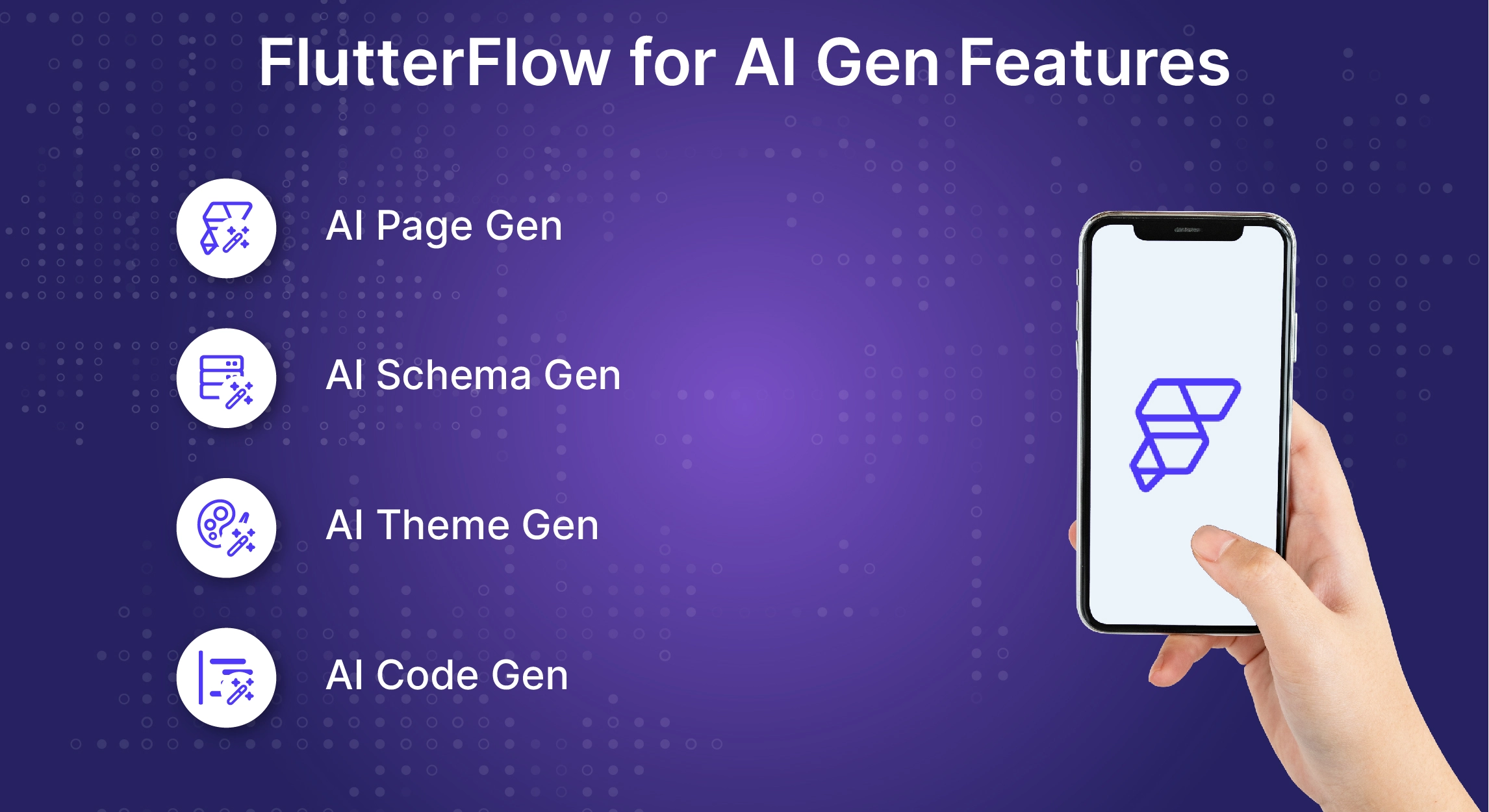
🟠 AI Page Gen
Kickstart your app development by prompts and customize the results as per your convenience, then add it to your project and export it.
🟠 AI Schema Gen
Easily generate backend schema in record time. You can easily create a scalable and interconnected database with simple prompts based on your thoughts.
🟠 AI Theme Gen
Creating unique and beautiful color schemes has never been accessible with simple text descriptions or prompts. No more hex code matching, just simple and elegant visually appealing applications.
🟠 AI Code Gen
Feel the power of AI Code Gen in FlutterFlow’s custom code editor. Get exceptional code suggestions instantly accessible within the platform.
FlutterFlow Pricing
It offers exciting, easily affordable plans and is readily available. You can choose a preferred plan that best suits your interest and requirements. It allows you to get started for free quickly or prefer an upgraded version of the pricing plan for advanced features. The pricing plans in the US are as follows:
🟠 Free Plan
As the name suggests, the free plan is free to use without any hidden cost. It lets you have core platform features, collaborations, and more, such as pre-built templates, Firebase integrations, and 2 API endpoints.
🟠 Standard Plan
This plan includes all the standard features from the free plan, sample applications, and the option to build and download the APK and easily download the code from the mobile applications you create. The cost of the standard plan is $30/month.
🟠 Pro Plan
The Pro plan is an upgraded version that includes all the offerings of the Free and Standard plan with added features such as custom APIs, GitHub, Codemagic integration, Firebase content manager, one-touch app translation, app and play store deployment, chat support and much more. The cost of a pro plan is $70/month.
🟠 Teams
Now, coming onto the Teams plan, it is the more extensive version of the pro plan, along with a few add-on features such as managed billing and a shared design library. The team plan costs $70/month per user for up to 10 users.
👉 Note: These paid plans are limited to organizations with an annual revenue of less than $10M.
Companies Using FlutterFlow
FlutterFlow offers to develop cross-platform applications so that you can use a single codebase to run on both the iOS and Android platforms. Not only citizen developers, novice coders, and designers, but many renowned companies also prefer low-code and no-code platforms. A few top companies that use FlutterFlow low-code platform for their application are:
- BMW
- Sonos
- Betterment
Comparing FlutterFlow With Other Low-Code Platforms
Traditional software development requires a thorough understanding of several metrics, such as sourcing, programming languages, and scripting. FlutterFlow is a knight in shining armor for many who are not as efficient in coding as some experienced developers, including novice developers, designers, non-technical individuals, and many more. However, there are many others as well that work on the same aspects as FlutterFlow. So, let us compare FlutterFlow with two of the other most prominent low-code platforms circumferentially.
FlutterFlow vs Draftbit
Initially, comparing FlutterFlow vs Draftbit, FlutterFlow is a web-based tool that enables you to build native and cross-platform mobile applications. It is built using the Flutter framework that helps speed up the development process.
In contrast, Draftbit is a no-code visually enabling development platform that allows you to create React Native mobile applications. Using this tool, you can easily export production-level source code based on React Native. Talking about the primary comparison between the two:
| Parameter | FlutterFlow | Draftbit |
|---|---|---|
| Customer Support | Extensive | Extensive |
| Pricing | From Free up to $70/month | From Free up to $199/month |
| Complexity Support | Better | Good |
| Availability of Developers | Easily Available | Easily Available |
| Language/Framework Used | Dart by Google | React Native by Facebook |
Thus, we can simply say that Flutter Flow and Draftbit have extensive functionality for their low-code or no-code application development. The better option depends on your respective use cases. When you want to develop a more complex, agile, and highly functional application, Draftbit is a viable choice. However, if you are planning for a more economical option and aim for a stable MVP development, Flutterflow.io is the better option.
FlutterFlow vs Bubble
When comparing Bubble vs FlutterFlow, we can easily infer that both the low-code platforms offer extensive features and functionalities. On one hand, Bubble has in-built features such as user authentication, email integration, and payment processing. Also, it offers a robust plugin library that presents many more extensive functionalities. FlutterFlow, on the other hand, is a comparatively new platform that is still on its way to developing many functionalities but still offers several inbuilt functionalities. Now, jumping onto the primary comparison between the two:
| Parameter | FlutterFlow | Bubble |
|---|---|---|
| Customer Support | Extensive | Extensive |
| Pricing | From Free up to $70/month | From Free up to $349/month |
| Community Support | Slack and Video Tutorials | 900k Community of Developers |
| Usability | More Customizable | Ideal for Beginners |
| Can Create | Mobile and Web Apps | Mobile and Web Apps |
With this comparison, we can infer that if you are a beginner looking for some intuitive interfaces along with an extensive set of inbuilt features, Bubble.io is a feasible option. However, if you aim for a more design-flexible option with customizability and similar features, FlutterFlow is your go-to choice.
Conclusion
This is all we have in our Pandora box on the all-around aspect of the FlutterFlow.io low-code platform. It is an excellent choice to deliver exceptional results. Turn your ideas into products, and with its easy-to-use drag-and-drop interface, you can quickly build visually appealing mobile applications without writing a single line of code.
We are sure that this extensive blog post on FlutterFlow has given you significant insights into what you seek; however, if you are a business owner and are confused about how Flutterflow.io can benefit your application development and speed up the delivery, partner with a professional Flutter App Development Company like Bacancy and experience how low-code platforms will transform the future of web and mobile application development and how you can stay ahead of the crowd and start using them today.
Frequently Asked Questions (FAQs)
FlutterFlow is a browser-based drag-and-drop interface that enables building visually stunning mobile apps without writing a single line of code.
FlutterFlow can be used for making native functionality in no time or testing it within the market with a simple application. While, Flutter can be a better option if you aim for more technology code-centric approach, better adaptability, and extensive customizability.
FlutterFlow doesn’t support different environments, such as production and staging. Also, only one Firebase project is available for production and staging, which can be resolved using a custom backend or a different low-code backend.
The FlutterFlow Templates are the user-built components and templates you can easily add to your FlutterFlow project. You can access the FlutterFlow Templates via FlutterFlow Marketplace.
Your Success Is Guaranteed !
We accelerate the release of digital product and guaranteed their success
We Use Slack, Jira & GitHub for Accurate Deployment and Effective Communication.





